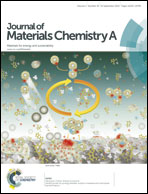Core/shell-shaped CdSe/PbS nanotetrapods for efficient organic–inorganic hybrid solar cells
Abstract
Core/shell-shaped CdSe/PbS nanotetrapod (NT), a novel nanostructure, has been synthesized and incorporated as an electron acceptor in organic–inorganic hybrid bulk-heterojunction (HBH) solar cells with poly(3-hexylthiophene) (P3HT) acting as an electron donor. The composite NT shows an homogeneous decoration of 4 nm PbS quantum dots on the CdSe NT surface, forming an inorganic heterojunction with a type-II band alignment. Compared to pure CdSe NT, the core/shell-shaped NT demonstrates an improved performance on splitting photogenerated exciton in P3HT. The charge reverse transfer (leakage or recombination) at the heterojunction interface is suppressed due to a potential barrier that is as high as 0.5 eV for CdSe/PbS NT. Furthermore, charge transport and collection are also enhanced through the spatially isolated charge channels of P3HT (for holes) and the CdSe core (for electrons). The efficient exciton dissociation and charge collection greatly contribute to the photovoltaic performance improvement. Compared with the P3HT:CdSe hybrid solar cell, a remarkable efficiency enhancement of 76% is achieved by incorporating the P3HT:CdSe/PbS hybrid with a donor–acceptor mass ratio of 1 : 6.


 Please wait while we load your content...
Please wait while we load your content...